Philadelphia, PA — The increasing tempo of pro-immigrant, anti-ICE protests hit Philadelphia last week, and the Philadelphia Police Department (PPD) has decided to crack down.
On Tuesday, June 10, and Saturday, June 14, autonomous protests were called outside of the Federal Detention Center (FDC), where up to 125 immigrant detainees can be held by Immigration and Customs Enforcement (ICE). The Tuesday protest included 80-100 protesters, while the Saturday demonstration brought an estimated 300. Both marches were met with intense police response which resulted in injuries and arrests.
Unlike other cities, where police shot tear gas and rubber bullets into crowds, the Philadelphia Police Department dispersed marches with tools on hand: battering protesters with batons, corralling the crowd with bicycles and nearly running activists and journalists over with motorized dirt bikes.
In October 2020, following protests against the killings of George Floyd and Walter Wallace Jr., the Philadelphia City Council passed a ban on the use of tear gas and rubber bullets on protesters. Additionally, a 2023 lawsuit resulted in a $9 million settlement awarded to activists, organizers and West Philly residents who were harmed by police use of tear gas.
This report covers how police repressed the June 10 and 14 demonstrations that roamed the northeast side of Center City — video from June 14 below.
June 10 Autonomous Demonstration: Philadelphia Police Arrest 15 Anti-ICE Protesters, Strike with Batons
Nationwide protests had taken off in solidarity against the recent militarized crackdowns and immigration sweeps in Los Angeles, as well as in objection to local ICE detentions. On the morning of June 10, ICE arrested at least one individual in South Philadelphia. Local activists also witnessed three detained in Kensington earlier that week.
In response to these detentions, an autonomous protest was called that morning to mobilize that afternoon. At 4 p.m., approximately 80-100 people congregated near the FDC at 7th and Arch Street and began chanting. A megaphone was passed among the crowd, and participants gave speeches about the Trump administration’s “fascist” immigration policies, as well as the interrelated struggle between domestic colonialism and the genocide in Gaza. (Local protesters also have been rallying weekly against one of Israel’s arms suppliers, Day & Zimmermann, on Spring Garden Street.)

A march then began, trekking past the ICE field office and then down Market Street, taking the prominent throughway. At the end of the second lap, police began pressuring the protest and at 6:44 p.m., issued a order to disperse. The Philadelphia Police Department (PPD) then flanked the crowd in an attempted kettle, struck several people with batons and arrested 15.
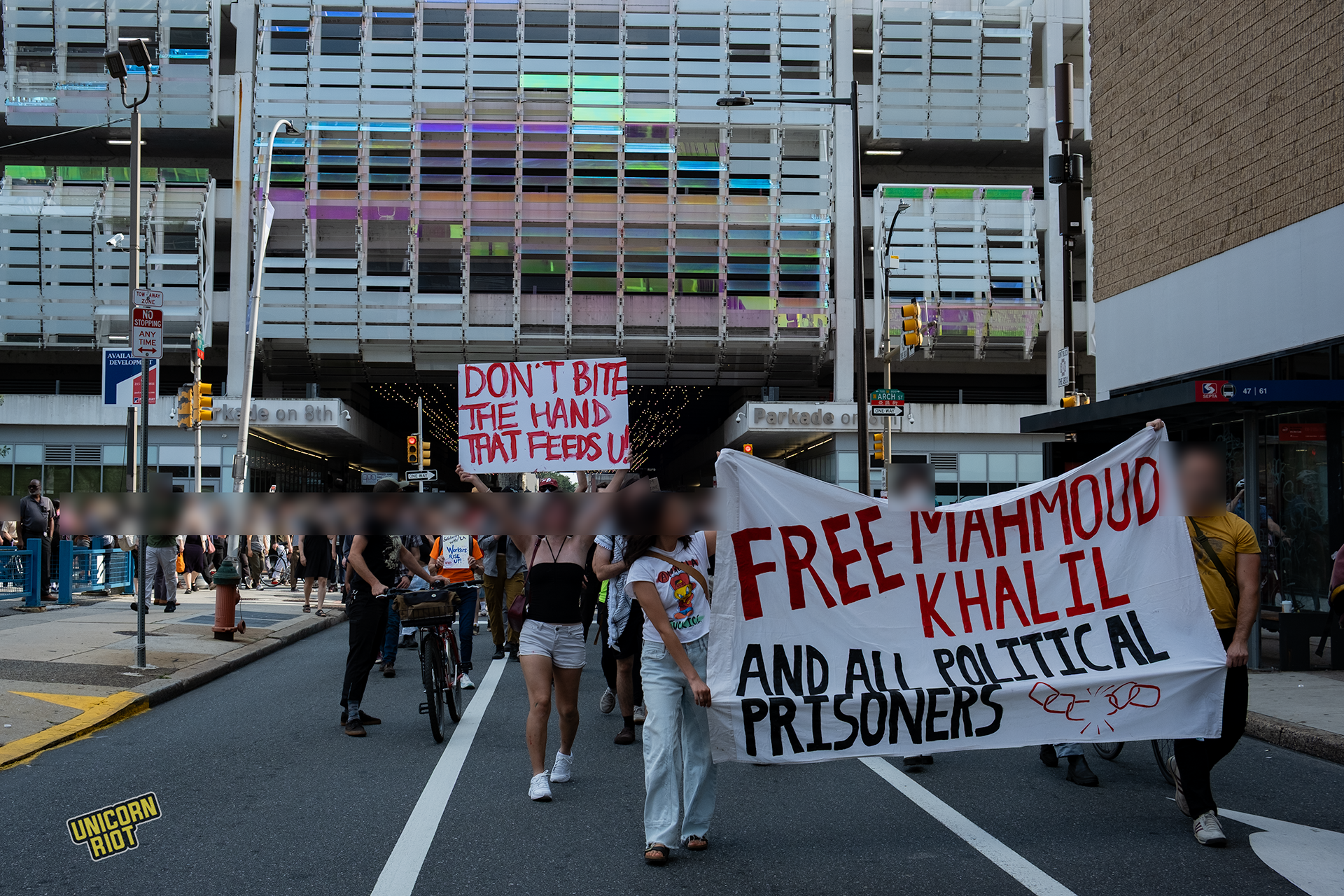
Activists marched around the block to the ICE field office, looped back to the FDC, and then took another lap onto Market Street.
Several protesters used bikes to define the march’s perimeter, acting in sync during the protest. On the second return to FDC Philadelphia, tensions escalated between Philly PD bike patrol and the bike brigade activists. They faced off closely and argued for some time.
One protester from the bike brigade explained:
“From my perspective, the bikers present maintained control and effectively managed the situation, preventing a rush. This strategic positioning, I believe, was not favored by the police, leading to their attempt to accelerate matters. I also heard from someone that there was communication over the scanner indicating an intent to arrest the bikers, and myself. Our actions were entirely within legal bounds; we were simply employing strategic measures to maintain a safe distance and manage the situation effectively.”
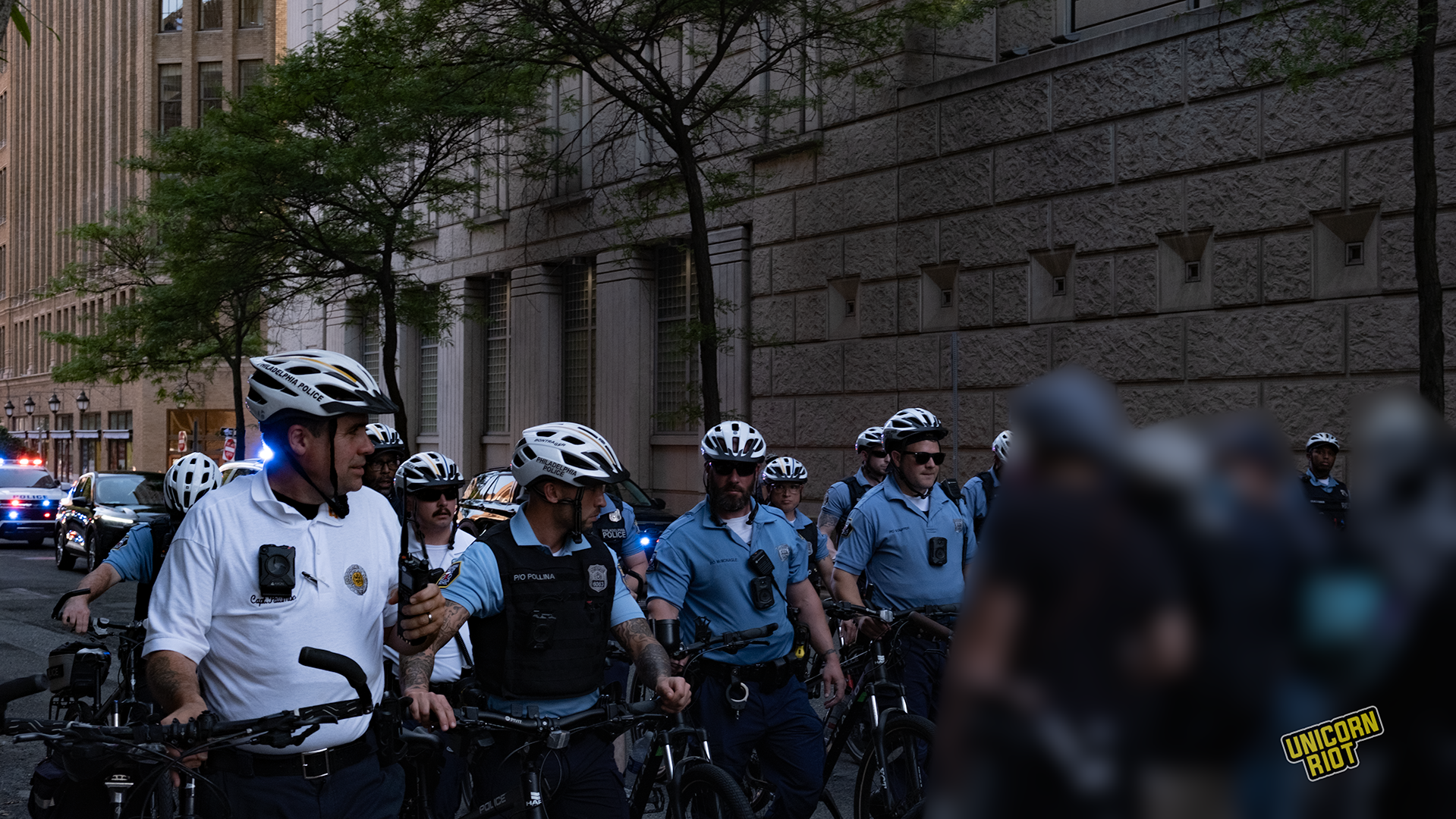
After the protest returned to the FDC, two bike cops were isolated by the crowd in front of the detention center. While activists and police exchanged verbal insults, at least one person in the crowd advised others to make sure that police could retreat from the cornered situation.
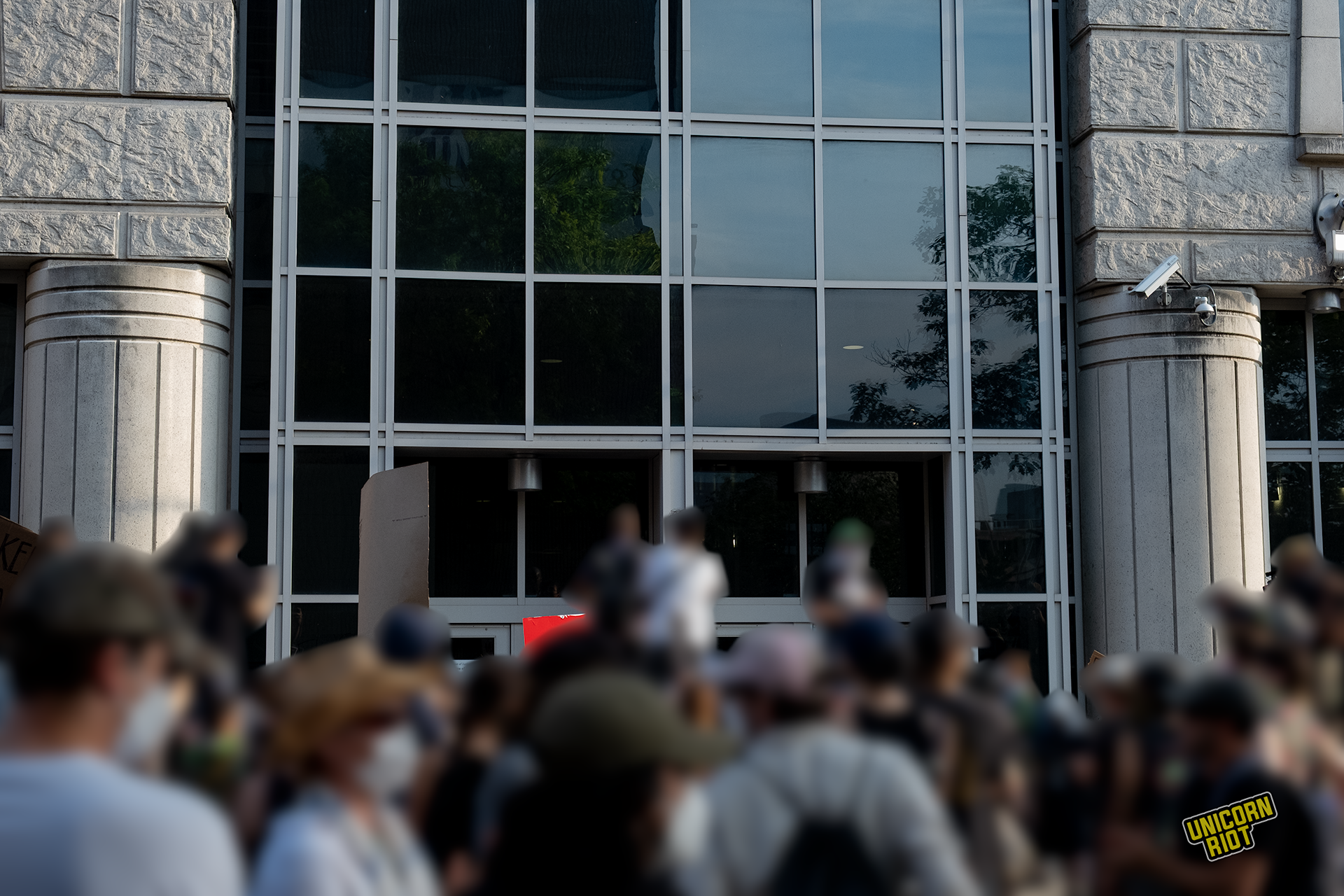
By this time, tensions were high. While there was no evidence of spray painted graffiti or significant property damage on the facility, a message was written onto one of the windows appearing to say “FUCK ICE.”
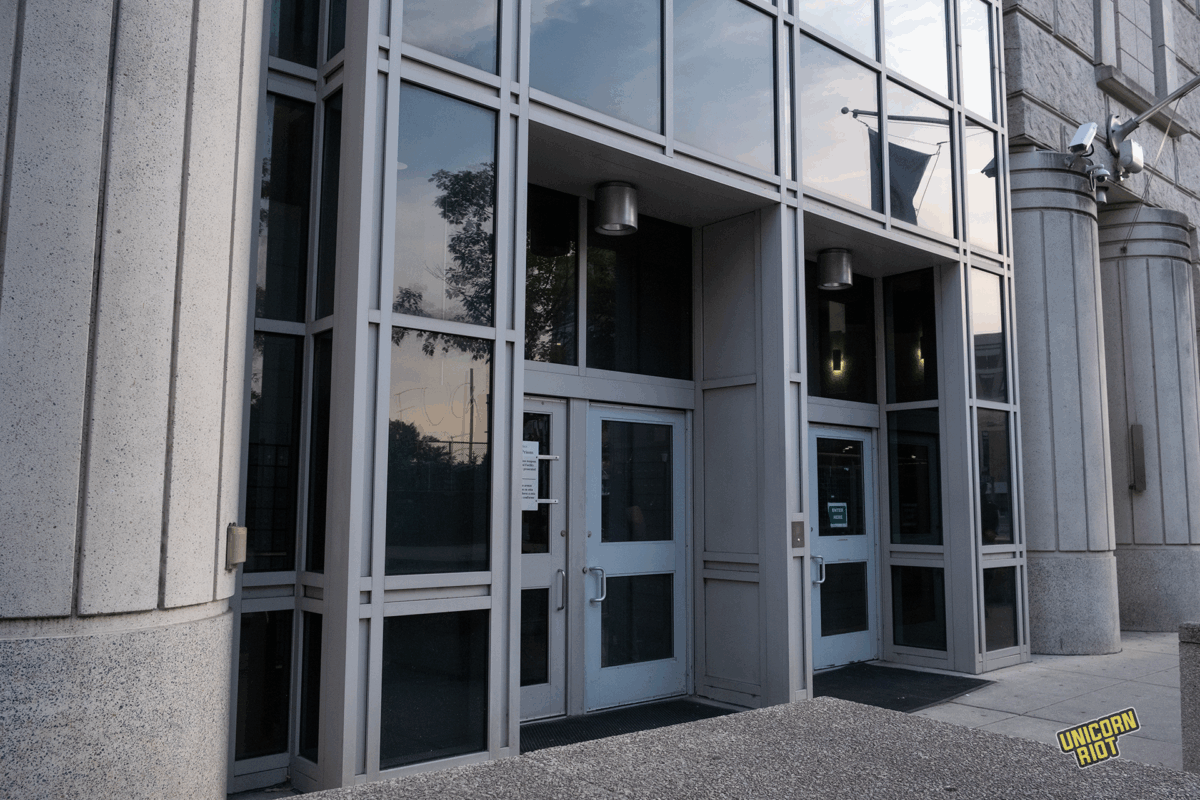
At approximately 6:44 p.m., the police issued an initial dispersal order, declaring the march “unlawful.”
The PPD then pressured protesters to keep moving, issuing a third dispersal order by 6:51 p.m. However, these declarations were not easily audible — our contributor could not hear them on site. An increased presence of officers, prepared with batons and riot gear, began following the protesters from behind.
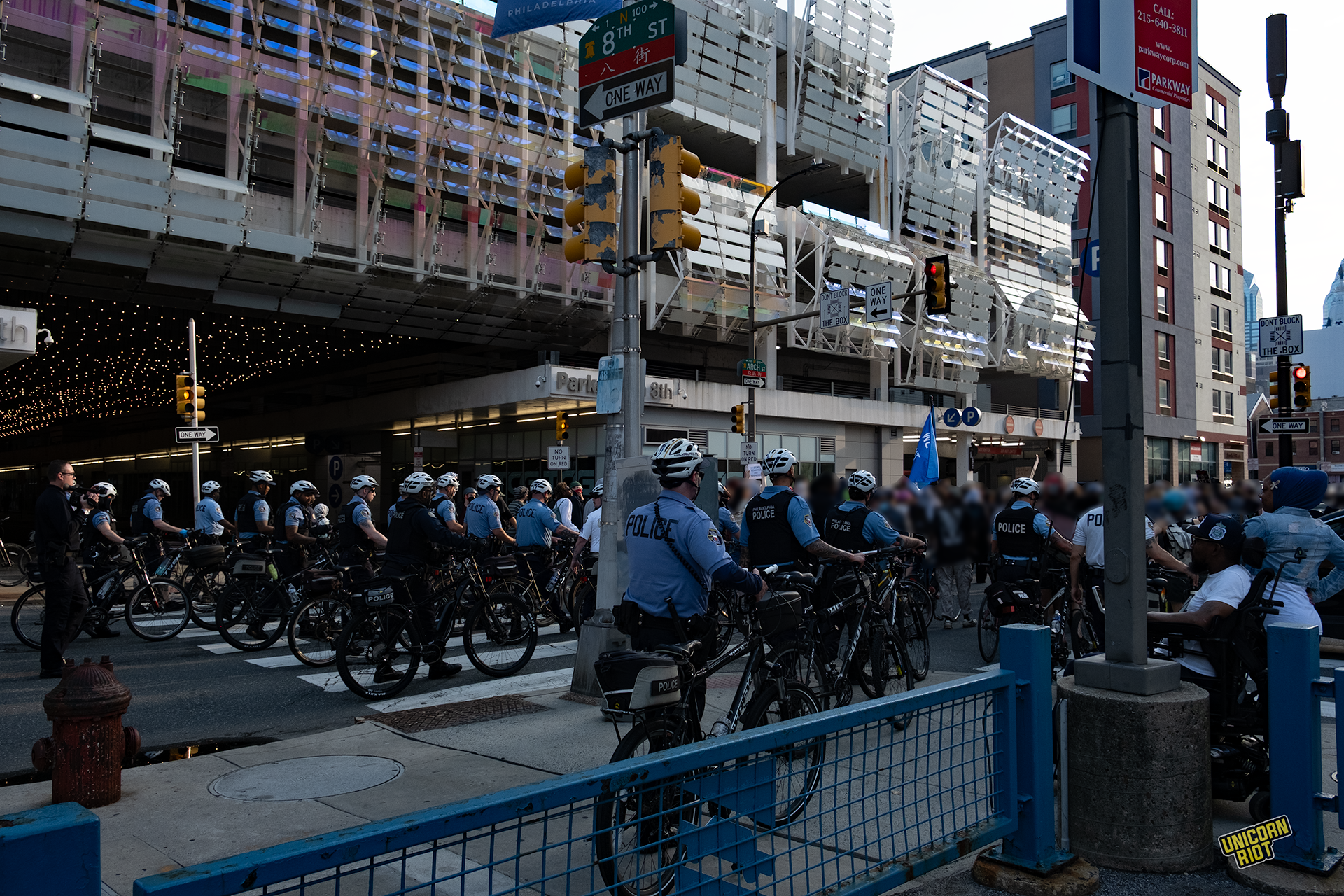
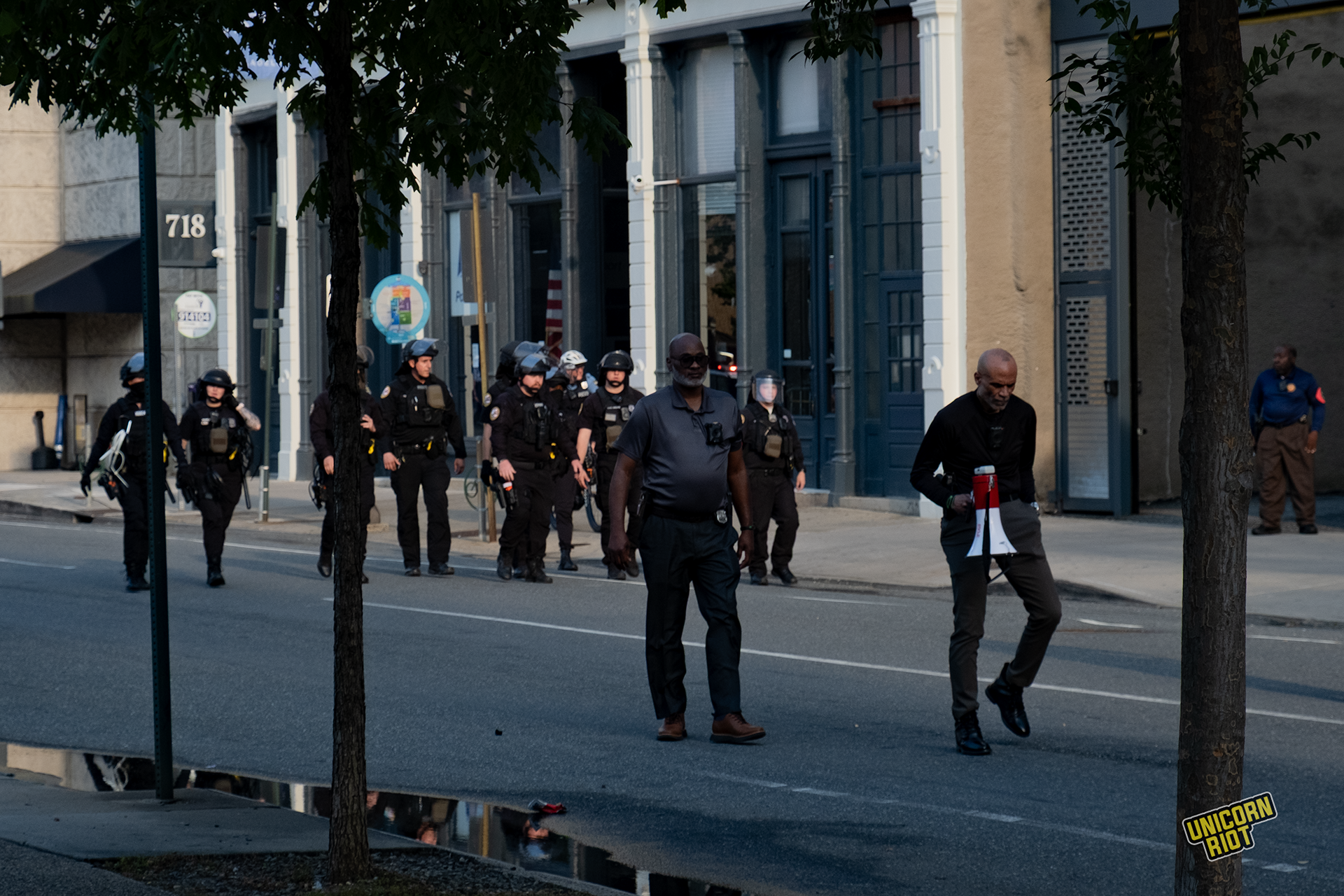
At around 7 p.m., police announced via their radios that they were planning arrests.
When the march reached Market St., police began to clash with protesters.


“They held the line when we got to Market Street. And they scared people. And, what do scared people do? They run. But then [the cops] started beating people,” one protester recounts. “There was no way out, so you had to run through or cower and hope they didn’t hurt you. If you ran, they tried to beat you.”
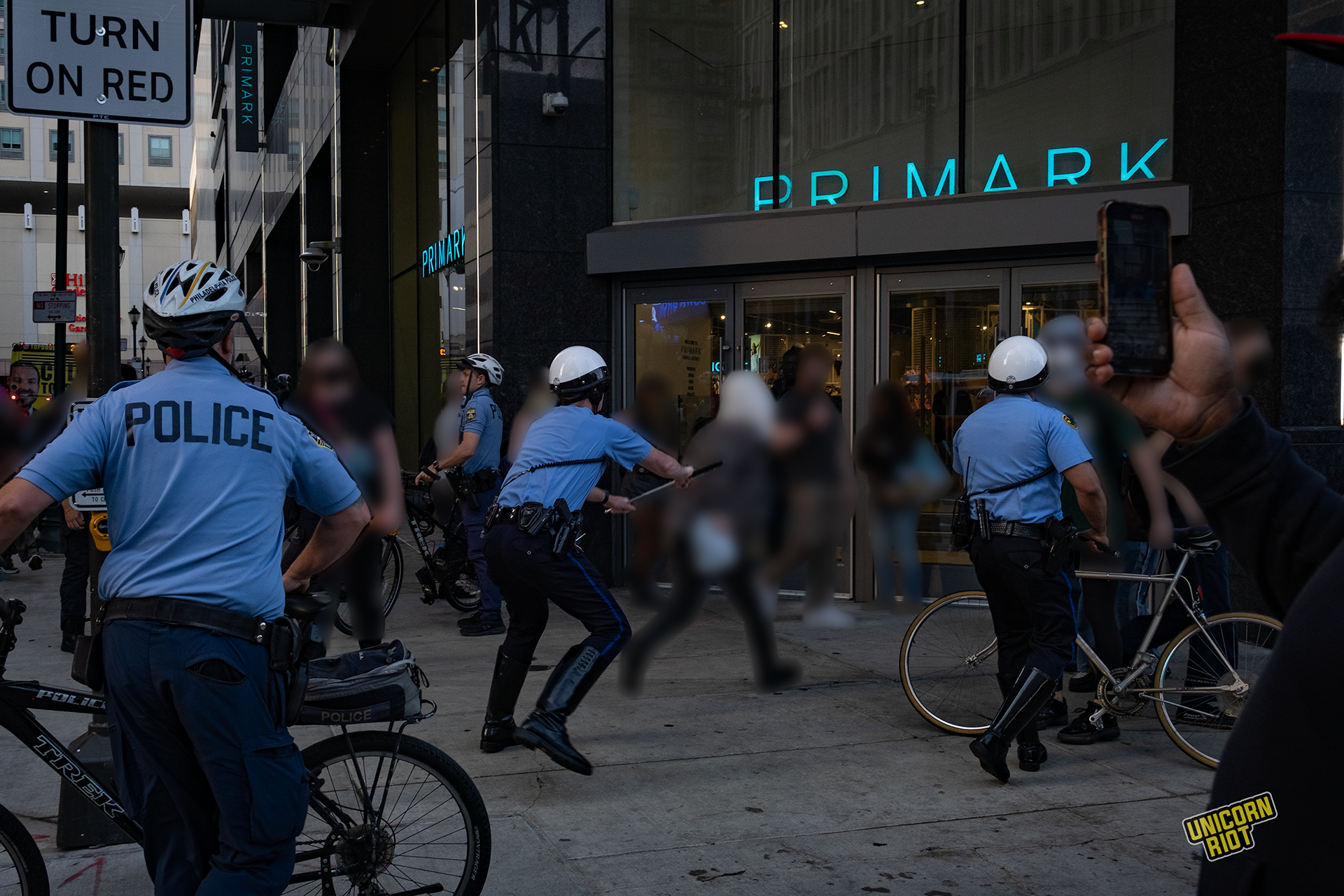





Fifteen people were arrested. Fourteen were hit with disorderly conduct, which is a ticketed offense called a CVN in Philadelphia. (There were press reports of another charge of aggravated assault but this has not been confirmed as of press time.)
In at least one documented instance, a Philadelphia officer kneeled on a protester’s neck. Two arrested protesters and two police officers received medical attention after.
As of 10 p.m. on June 11, additional barricades were placed around the FDC and its large window facade was boarded up.
June 14 Autonomous Demonstration: Protesters Flee Attacking Bike Cops via Holiday Inn Express
Liberal groups returned to Philly to host the “No Kings” national flagship rally on June 14 at the Philadelphia Museum of Art; messages against ICE policy were a major theme. Facing light rain at 2 p.m., much of the 80,000 person crowd began drifting back towards City Hall from the art museum.
Shortly after, an autonomous demonstration against ICE gathered again near the FDC around 6 p.m. with a message in solidarity with the revolt by ICE detainees in Delaney Hall detention facility in Newark, which is operated by the GEO Group. Last Friday, the Department of Homeland Security claimed four people escaped by knocking over an outer wall after an uprising among ICE detainees Thursday evening was spurred by a lack of food.

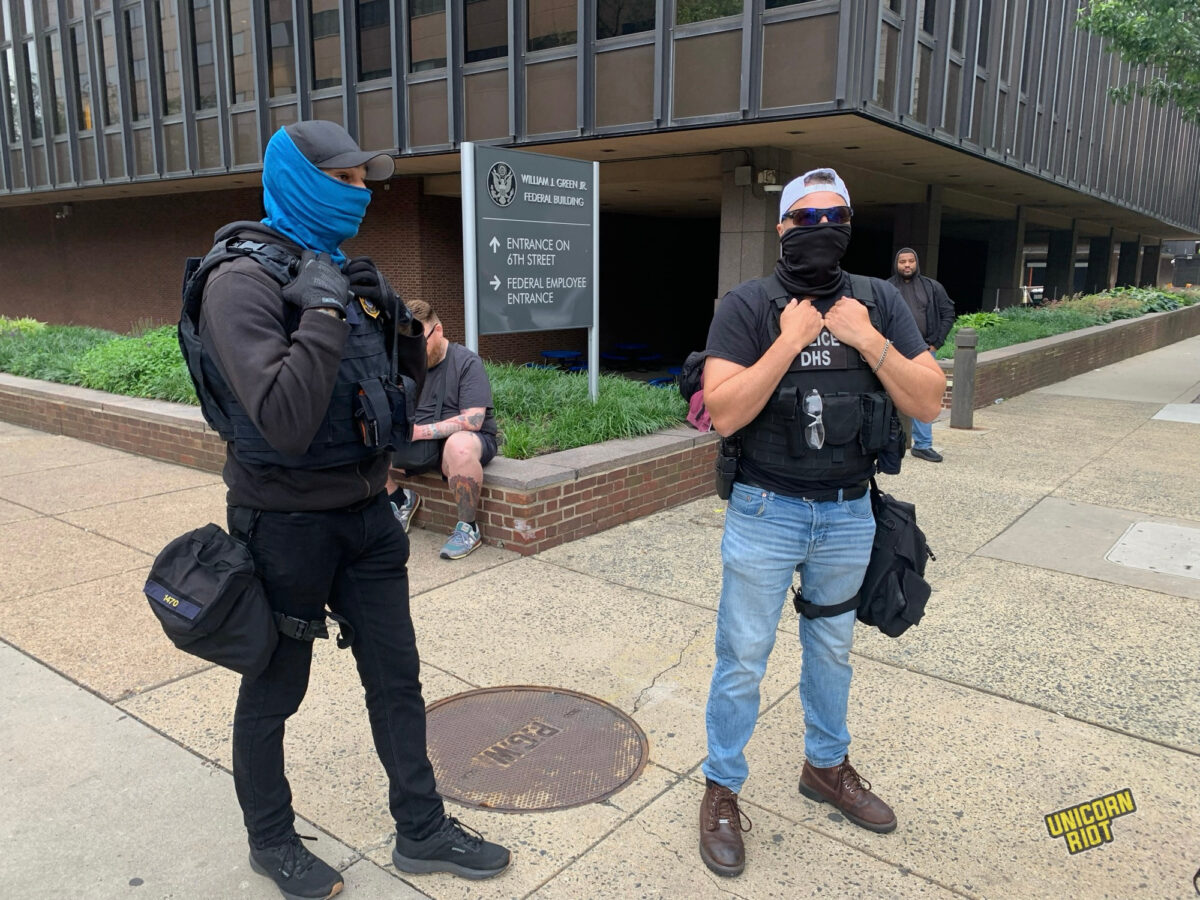
Police scanners noted that the Philly PD shadowed some roaming protest groups earlier in the afternoon, as some “No Kings” protest participants joined into the autonomous gathering. Before the 6 p.m. protest began, dozens of cops stationed in groups around the FDC. Dirt bike police staged nearby on Broad Street, and sanitation trucks blocked street traffic around the FDC.
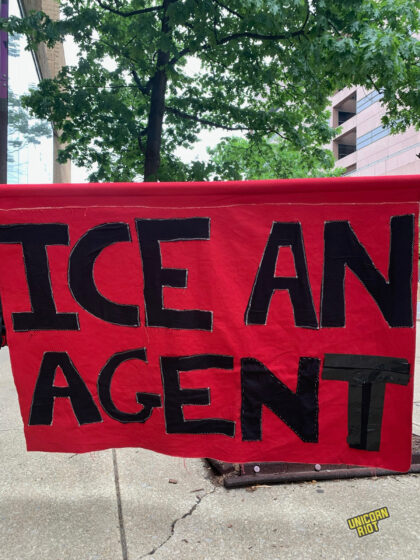
Shortly after the march began, over 100 Philly Police quickly corralled the protest to stop it from heading down 7th Street towards the highway. The group instead marched into Center City towards the Fashion District as bike cops followed.
— Unicorn Riot (@unicornriot.bsky.social) June 14, 2025 at 6:44 PMLATEST: Over 100 Philly Police quickly corralled the protest to stop it from marching on 7th towards the highway – the group is now heading into Center City as bike cops follow NOW: Approximately 300 anti-ICE protesters heading into Fashion District

The anti-ICE march snaked around northeast Center City. At 12th and Walnut there was a scuffle, after protesters repurposed plastic jersey barriers to obstructed bike police following the march. Officers had to push these out of way. Then, officers began to grab march participants with masks and umbrellas. Unicorn Riot saw what appeared to be several successful de-arrests.

At 13th and Walnut, at about 7 p.m., after the conflict over barricades, police attacked the crowd and kettled it at the intersection. Some protesters then ran through the Holiday Inn Express garage. Police with bicycles lined up to cut off garage access, splitting the crowd. PPD ordered people to leave while they had everyone surrounded, and eventually let some march away while issuing dispersal orders.
This time around, the police had added dirt bike-type motorcycles to their arsenal. Philly Police on motorbikes nearly ran over people’s feet repeatedly, repeatedly zooming across a block to come within an inch or so of striking our reporter as well as a small handful of protesters leaving the area.
— Unicorn Riot (@unicornriot.bsky.social) June 14, 2025 at 9:45 PMOne Philly PD bike team officer's taunts to anti-ICE protesters, made shortly before using force, highlights the larger issue of how police culture impacts the handling of demonstrations: "I'd love for you to get close enough. I pray for it."
Once again there were arrests and injuries — legal observers tell us there were approximately seven arrests. One person was released immediately, two the following evening, and others are awaiting charges.
Future ICE Activity Expected in Philadelphia
Philadelphia may see more militarized ICE actions soon. Detentions of immigrants have continued regularly around Philadelphia and its suburbs.
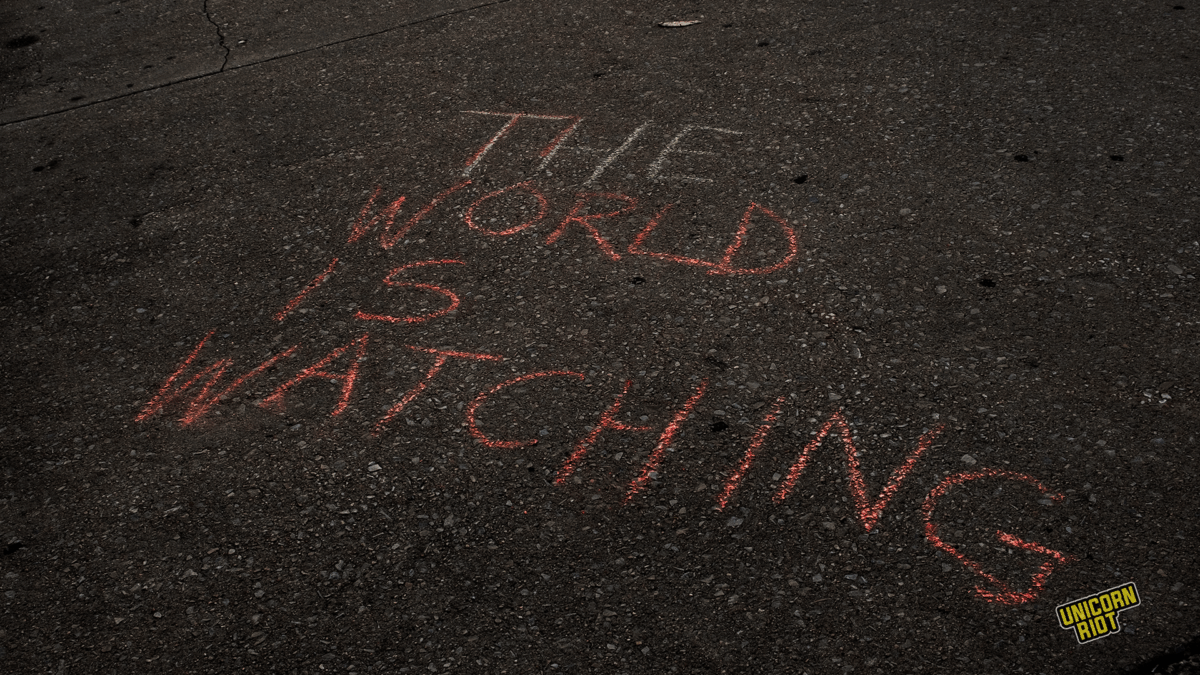
A report by NBC News said that Special Response Team (SRT) tactical units are expected in the city, as well as in Chicago, Seattle, Northern Virginia and New York. These may be similar to the SRT deployments that spurred major protests in Los Angeles and Minneapolis last week.
Unicorn Riot leaked the SRT ICE Homeland Security Investigations “team handbook” back in 2019.

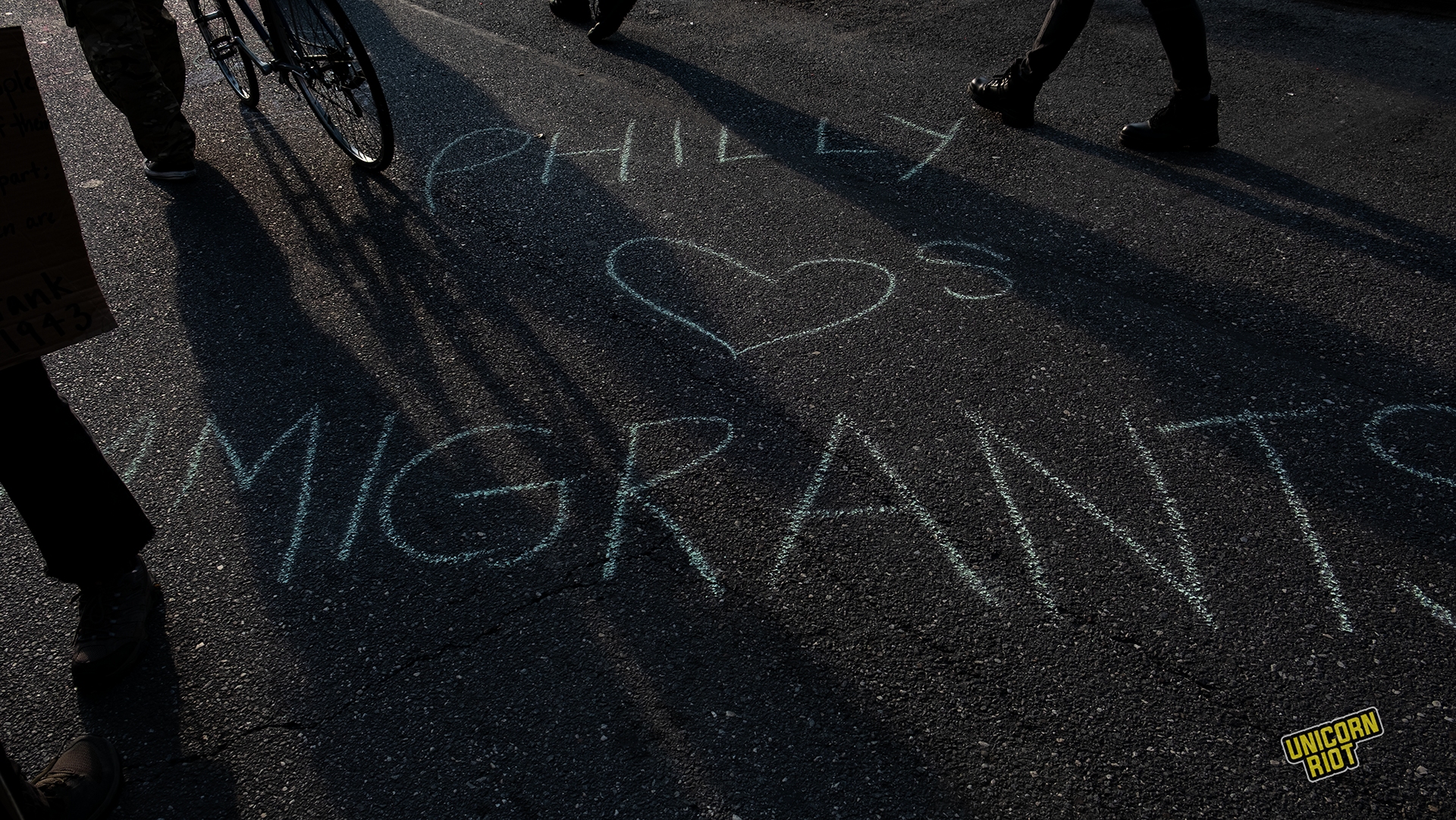
Chris Schiano contributed to this report for Unicorn Riot.
Follow us on X (aka Twitter), Facebook, YouTube, Vimeo, Instagram, Mastodon, Threads, BlueSky and Patreon.
Please consider a tax-deductible donation to help sustain our horizontally-organized, non-profit media organization:
Published June 17, 2025
